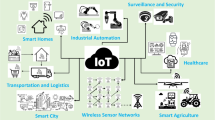Abstract
As a computing service platform closer to users, fog computing has many advantages such as extremely low latency, good mobility, accurate location perception and wide distribution. It has developed rapidly in recent years. However, due to the wide distribution of fog nodes, complex network environments, and limited resources, the security of fog nodes is vulnerable to a variety of attacks, such as denial of service and abuse of resources. In order to effectively deal with these attacks, this paper proposes a quantum fog computing model based on blind quantum computation and verifiable quantum secret sharing. The model mainly relies on blind quantum computation to realize the security joint operation characteristics of multiple fog nodes, and the identity verifiable and channel detection protection features provided by the quantum secret sharing protocol, which can not only efficiently perform the functions of the classic fog computing, but also guarantee the security of information transmission and data calculation. Through the complete security analysis, the new quantum fog computing model proposed in this paper can effectively resist on a variety of fog computing attacks, thus achieving information security protection in both the content and process of fog computing.










Similar content being viewed by others
References
Affleck I, Kennedy T, Lieb EH, Tasaki H (1988) Valence bond ground states in isotropic quantum antiferromagnets. Commun Math Phys 115(3):477–528
Barenco A, Bennett CH, Cleve R, DiVincenzo DP, Margolus N, Shor P, Sleator T, Smolin JA, Weinfurter H (1995) Elementary gates for quantum computation. Phys Rev A 52(5):3457–3457
Barz S, Kashefi E, Broadbent A, Fitzsimons JF, Zeilinger A, Walther P (2012) Demonstration of blind quantum computing. Science 335(6066):303–308
Briegel HJ, Raussendorf R (2001) Persistent entanglement in arrays of interacting particles. Phys Rev Lett 86(5):910–913
Broadbent, A, Fitzsimons J, Kashefi E (2009) Universal blind quantum computation. In: 2009 50th annual IEEE symposium on foundations of computer science, IEEE, pp 517–526
Chiang M, Zhang T (2016) Fog and iot: an overview of research opportunities. IEEE Internet Things 3(6):854–864
Childs AM (2005) Secure assisted quantum computation. Quantum Inf Comput 5(6):456–466
Deutsch DE (1989) Quantum computational networks. Proc R Soc Lond Ser Contain Papers Math Phys Character 425(1868):73–90
Dou Z, Xu G, Chen X, Yuan K (2019) Rational non-hierarchical quantum state sharing protocol. CMC-Comput Mater Con 58(2):335–347
Kong X, Qin L, Wu C, Fang Y, He J, Sun Z (2016) Multiple-server flexible blind quantum computation in networks. Int Nt J Theor Phys 55(6):3001–3007
Li Q, Chan WH, Wu C, Wen Z (2014) Triple-server blind quantum computation using entanglement swapping. Phys Rev A 89(4):040302
Li Q, Li Z, Chan WH, Zhang S, Liu C (2018) Blind quantum computation with identity authentication. Phys Rev A 382(14):938–941
Liu XF, Yan XH, Yao ZQ (2012) Multiparty quantum secret sharing protocol with authentication. J Chin Comput Sys 33(11):2518–2521
Liu W, Chen Z, Liu J, Su Z, Chi L (2018) Full-blind delegating private quantum computation. CMC-Comput Mater Contin 56(2):211–223
Morimae T (2012) Continuous-variable blind quantum computation. Phys Rev Lett 109(23):230502
Morimae T, Fujii K (2012) Blind topological measurement-based quantum computation. Nat Commun 3:1036–1037
Morimae T, Fujii K (2013) Secure entanglement distillation for double-server blind quantum computation. Phys Rev Lett 111(2):020502
Mell P, Grance T (2011) The NIST definition of cloud computing. Commun ACM 53(6):50–53
Qu Z, Zhu T, Wang J, Wang X (2018) A novel quantum stegonagraphy based on brown states. CMC-Comput Mater Contin 56(1):47–59
Qu Z, Wu S, Liu W, Wang X (2019) Analysis and improvement of steganography protocol based on bell states in noise environment. CMC-Comput Mater Con 59(2):607–624
Raussendorf R, Briegel HJ (2001) A one-way quantum computer. Phys Rev Lett 86(22):5188–5189
Raussendorf R, Harrington J, Goyal K (2007) Topological fault-tolerance in cluster state quantum computation. New J Phys 9(6):199–199
Sueki T, Koshiba T, Morimae T (2013) Ancilla-̄driven universal blind quantum computation. Phys Rev A 87(6):060301
Sun Y, Chen Y, Ahmad H, Wei Z (2019) An asymmetric controlled bidirectional quantum state transmission protocol. CMC-Comput Mater Contin 59(1):215–227
Tan X, Feng Z, Jiang L, Fang A (2013) Verifiable quantum secret sharing protocol. In: 2013 Fourth international conference on emerging intelligent data and web technologies, IEEE, pp 227–230
Tan X, Li X, Yang P (2018) Perfect quantum teleportation via bell states. CMC-Comput Mater Con 57(3):495–503
Vaquero LM, Rodero-Merino L (2014) Finding your way in the fog: towards a comprehensive definition of fog computing. Acm Sigcomm Comp Com 44(5):27–32
Wenqian L (2017) The study on key problems of secure multi-party quantum computation. Southeast University, Jiangsu
Yi S, Hao Z, Qin Z, Li Q (2015) Fog computing: platform and applications. In: 2015 Third IEEE workshop on hot topics in web systems and technologies (HotWeb), IEEE, pp 73–78
Zhang H, Qiu Y, Chu X, Long K, Leung VC (2017) Fog radio access networks: mobility management, interference mitigation, and resource optimization. IEEE Wirel Commun Le 24(6):120–127
Acknowledgements
This work was supported by the National Natural Science Foun- dation of China (No. 61373131, 61601358, 61501247, 61672290, 61303039, 61232016), Natural Science Foundation of Jiangsu Province (Grant No. BK20171458), Sichuan Youth Science and Technique Foundation (No.2017JQ0048), Open Foundation of State key Laboratory of Networking and Switching Technology (Beijing University of Posts and Telecommunications) (SKLNST-2020-1-17), PAPD and CICAEET funds.
Author information
Authors and Affiliations
Corresponding authors
Additional information
Publisher's Note
Springer Nature remains neutral with regard to jurisdictional claims in published maps and institutional affiliations.
Rights and permissions
About this article
Cite this article
Qu, Z., Wang, K. & Zheng, M. Secure quantum fog computing model based on blind quantum computation. J Ambient Intell Human Comput 13, 3807–3817 (2022). https://doi.org/10.1007/s12652-021-03402-7
Received:
Accepted:
Published:
Issue Date:
DOI: https://doi.org/10.1007/s12652-021-03402-7




